
Plane Crazy is a 1928 American animated short film directed by Walt Disney and Ub Iwerks. The cartoon, released by the Walt Disney Studios, was the first appearance of Mickey Mouse and his girlfriend Minnie Mouse, and was originally a silent film. It was given a test screening to a theater audience on May 15, 1928, and an executive from Metro-Goldwyn-Mayer saw the film, but failed to pick up a distributor. Later that year, Disney released Mickey's first sound cartoon, Steamboat Willie, which was an enormous success; Plane Crazy was officially released as a sound cartoon on March 17, 1929. It was the fourth Mickey film to be given a wide release after Steamboat Willie, The Gallopin' Gaucho and The Barn Dance (1929).

Runaway Brain is a 1995 American animated comedy horror short film produced by Walt Disney Feature Animation. Featuring Mickey Mouse and Minnie Mouse, the short centers on Mickey attempting to earn money to pay for an anniversary gift for Minnie. He responds to an advertisement to work for Doctor Frankenollie, only to find out that he is looking for a donor to switch brains with the monster he created. Featuring animation by animator Andreas Deja, it was first released in 1995 attached to North American theatrical showings of A Kid in King Arthur's Court and in 1996 attached to international theatrical showings of A Goofy Movie. It would be the final original Mickey Mouse theatrical animated short until Get a Horse! in 2013.

Fun and Fancy Free is a 1947 American animated musical fantasy anthology film produced by Walt Disney and Ben Sharpsteen and released on September 27, 1947 by RKO Radio Pictures. The film is a compilation of two stories: Bongo, narrated by Dinah Shore and loosely based on the short story "Little Bear Bongo" by Sinclair Lewis; and Mickey and the Beanstalk, narrated by Edgar Bergen and based on the "Jack and the Beanstalk" fairy tale. Though the film is primarily animated, it also uses live-action segments starring Edgar Bergen to join its two stories.
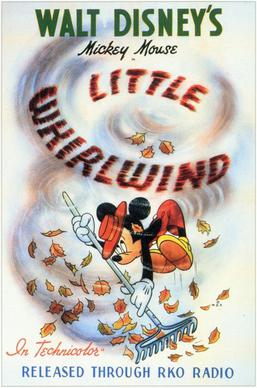
The Little Whirlwind is an animated short subject, part of the Mickey Mouse series, produced by Walt Disney for Walt Disney Productions. The short was released by RKO Radio Pictures on February 14, 1941. The film was directed by Riley Thomson, and animated by Ward Kimball, Fred Moore, Ken Muse, Jim Armstrong, Les Clark, John Elliotte, Fred Jones, Walt Kelly, and Frank Follmer with effects animation by Art Fitzpatrick. It was the 110th short in the Mickey Mouse film series to be released, and the first for that year.
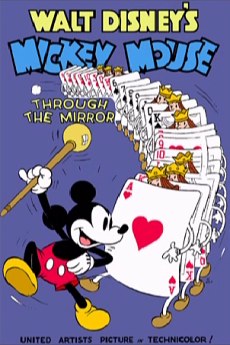
Thru the Mirror is a 1936 American animated short film directed by David Hand from a story by William Cottrell and Joe Grant. In this cartoon short, Mickey Mouse has a Through the Looking-Glass-parody-like dream that he travels through his mirror and enters a topsy-turvy world where everything is alive. While there, he engages in a Fred Astaire dance number with a pair of gloves and a pack of cards, until the cards chase him out of the bizarre world. Produced by Walt Disney Productions and released by United Artists, it was the 83rd Mickey Mouse short film to be released, the fourth of that year.

Wild Waves is a Mickey Mouse short animated film first released on December 18, 1929, as part of the Mickey Mouse film series. It was the fifteenth Mickey Mouse short to be produced, the twelfth of that year, as well as the last to be released by Celebrity Productions before Columbia Pictures took over distribution.

The Barn Dance is a Mickey Mouse short animated film first released on March 15, 1929, as part of the Mickey Mouse film series; it was the first of twelve shorts released during that year. It was directed by Walt Disney with Ub Iwerks as the head animator. The title is written as Barn Dance on the poster, while the full title is used on the title screen.
On Ice is a 1935 theatrical cartoon short in the Mickey Mouse film series, produced by Walt Disney Animation Studios. It was the 79th Mickey Mouse short film to be released, and the eighth of that year.
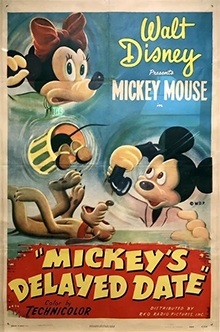
Mickey's Delayed Date is a 1947 American animated short film produced by Walt Disney Productions, distributed by RKO Radio Pictures and released on October 3, 1947. The film was directed by Charles Nichols and was animated by Jerry Hathcock, George Kreisl, George Nicholas, Harry Holt, Bob Youngquist, Marvin Woodward, and Max Cox with effects animation by Jack Boyd and Andy Engman. It was the 120th short in the Mickey Mouse film series to be released and the only one produced that year.

Giantland is a 1933 animated short film produced by Walt Disney Productions and distributed by United Artists. The film is an adaptation of the fairy tale "Jack and the Beanstalk" with Mickey Mouse in the title role. Mickey is voiced by Walt Disney and Mickey's nephews are voiced by Marcellite Garner, who at the time usually voiced Minnie Mouse. It was the 62nd Mickey Mouse short film, and the twelfth of that year.

Building a Building is a 1933 American animated short film produced by Walt Disney Production and released by United Artists. A remake of the 1928 Oswald the Lucky Rabbit film Sky Scrappers, the cartoon depicts Mickey Mouse working at a construction site under the supervision of Peg-Leg Pete while Minnie Mouse is selling box lunches to the workers. It was directed by David Hand, his first directorial assignment at Disney, and features the voices of Walt Disney as Mickey, Marcellite Garner as Minnie, and Pinto Colvig as Pete. It was the 51st Mickey Mouse short film, and the first of that year.

Mickey's Choo-Choo is a 1929 Mickey Mouse short animated film released by Celebrity Pictures, as part of the Mickey Mouse film series. Ub Iwerks was the animator. It was the eleventh Mickey Mouse short to be produced, the eighth of that year, and was one of the series of early Disney cartoons that led Mickey Mouse to become a national fad by the end of 1929. Originally produced in black and white, this cartoon was one of 45 Mickey Mouse cartoons colorized by American Film Technologies in 1991.

Hawaiian Holiday is a 1937 American animated short film produced by Walt Disney Productions and released by RKO Radio Pictures. The cartoon stars an ensemble cast of Mickey Mouse, Minnie Mouse, Pluto, Donald Duck, and Goofy while vacationing in Hawaii. The film was directed by Ben Sharpsteen, produced by John Sutherland and features the voices of Walt Disney as Mickey, Marcellite Garner as Minnie, Clarence Nash as Donald, and Pinto Colvig as Goofy and Pluto. It was Disney's first film to be released by RKO, ending a five-year distributing partnership with United Artists.

Pluto's Christmas Tree is a 1952 Mickey Mouse cartoon in which Pluto and Mickey cut down a Christmas tree that Chip n' Dale live in. It was the 125th short in the Mickey Mouse film series to be released, and the second for that year. While the chipmunks are usually antagonists of Donald Duck, they have pestered Pluto before, in Private Pluto (1943), Squatter's Rights (1946) and Food for Feudin' (1950).

Mickey Mouse is an American animated television series produced by Disney Television Animation. Featuring Disney cartoon characters Mickey Mouse, Minnie Mouse, Donald Duck, Daisy Duck, Goofy and Pluto in contemporary settings such as Paris, Venice, Tokyo and New York, the series has the slapstick feel of the earliest Mickey Mouse shorts while providing a modern update, and "presents Mickey in a broad range of humorous situations that showcase his pluck and rascality, along with his long-beloved charm and good heartedness". The animation is provided by Mercury Filmworks.

Mickey's Garden is a 1935 American animated short film produced by Walt Disney Productions and released by United Artists. The film was the second Mickey Mouse cartoon shot in Technicolor and is also the first color appearance of Pluto. The cartoon is also the first color cartoon where Mickey speaks. The film's plot centers on Mickey Mouse trying to rid his garden of insects, but they keep coming back. When he accidentally gets hit with his own bug spray, he begins seeing a warped reality. It was the 76th Mickey Mouse short film to be released, and the fifth of that year. The last dialogue of the show is Mickey telling Pluto to stop licking him in the last 20 seconds.

Ye Olden Days is a 1933 animated short film, released as part of the Mickey Mouse film series. It was directed by Burt Gillett and produced by Walt Disney. It was the 55th Mickey Mouse short film, and the fifth of that year.
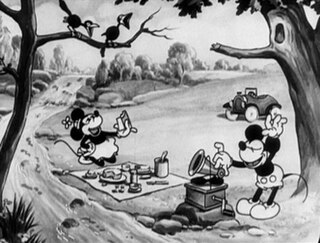
The Picnic is a 1930 American animated short film directed by Burt Gillett and produced by Walt Disney. It was first released on October 9, 1930, as part of the Mickey Mouse film series. It was the twenty-third Mickey Mouse short to be produced, the eighth of that year.
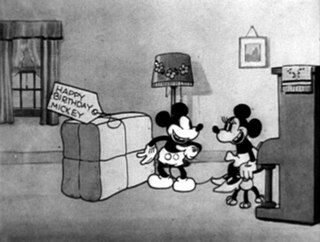
The Birthday Party is a Mickey Mouse short animated film first released on January 2, 1931, as part of the Mickey Mouse film series. It was the twenty-fifth Mickey Mouse short to be produced, the first of that year.


















